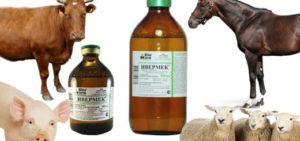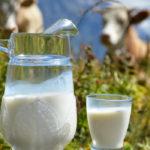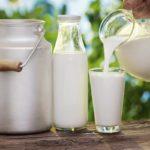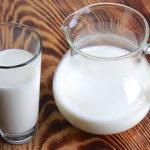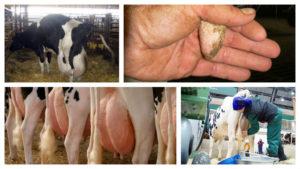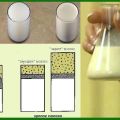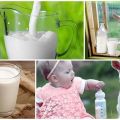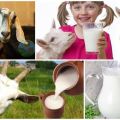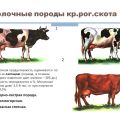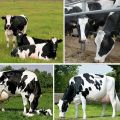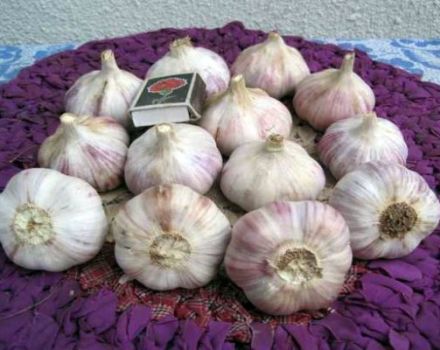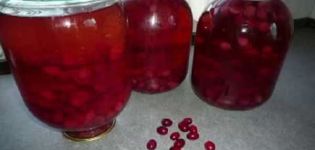What is the normal percentage of fat in homemade cow's milk and what it depends on
The fat content of milk is variable. It depends on many factors. The fat content in milk can be determined, for this there are special methods. Consider the methods of determining the fat content of cow's milk, the types of fat content, factors that affect how much fat will be contained in it, whether it is possible to increase the percentage of fat in cows at home.
Relative and total body fat
Cow's milk is 88% water. The rest consists of dry substances, a mixture of nutrients that are in an easily assimilated form. The dry residue also contains animal fat. The average fat content of whole milk for cows is 3.2%. This figure means that there are 3.2 ml of fat in 100 ml of liquid. The relative indicator is the fat content in 1 kg of milk (in percentage).
Fat content correlates with the amount of milk the cow gives. Usually fatty milk in those animals that cannot boast of high milk yield. Conversely, if a cow gives a lot of milk, it does not differ in special fat content. This pattern is typical for cattle of any direction - both dairy and meat.
At a rate of 3.2%, milk is suitable for normal consumption, for dietary consumption it is defatted. Baked milk is characterized by a reduced amount of water, so its fat content increases in this way. Fresh milk is of maximum importance. After a few hours, the fats in it begin to turn into other substances. Fat content depends on where the animals live - village cows produce a thicker product than those that are bred on farms.

For breeds, the percentage of fat can also differ. Jersey cows have the fattest milk - an average of 4.5-6%, the maximum - as much as 8%. The breed's milk yield is small (3 thousand liters per year), but purebred animals are used to improve the characteristics of other breeds. Holstein cows have a maximum milk yield of 12 thousand liters per year, but the milk is not fat.
Fat types
The dairy product is divided into types, taking into account the percentage of fat content:
- 0-1% - fat-free, intended for nutrition of people on a diet;
- 1-2% - for catering and the production of dairy products;
- 3.5% - normal fat content of fresh milk;
- 4.5-6% - only some breeds give such milk,
- 10% is an indicator typical for cream.
Fat content is a criterion that can tell a breeder which breed to choose for home breeding. If you plan to keep cows to get fresh milk for sale, then you can take a dairy cow with low-fat milk. If the product is intended for obtaining dairy products from it - cottage cheese, cheeses, then you need to take a cow with fat milk. The fat content also affects the taste of milk. So, tasty is one that has at least 3.2-3.8%.
Factors affecting the percentage of fat in cow's milk
There are several factors. These are the genetic potential of the animal, the diet of feeding, age and season. Each of them affects fat content by decreasing or increasing it.
Genetic level
In some dairy breeds, selection was and is being carried out on such a basis as the fat content of milk. The best representatives are selected for breeding, their offspring inherit the desired traits. However, even among purebred cows, phenotypic deviations from the standard are possible.
Belonging to the breed to some extent guarantees a certain percentage of fat content, since this characteristic is inherited in cows.
Fodder base
The potential inherent in the cow by nature and breeders can only be shown with proper feeding. If the animal is undernourished, or there are not enough important minerals in the feed, this will affect the fat content.

The food that a cow eats at home also matters. Fat in the body of ruminants is formed from acetic acid, the source of which is fiber obtained by animals from grass, hay, and silage. If there is not enough roughage in the cattle ration, the production of acetic acid decreases, the fat content decreases. The minimum fiber content in the diet of dairy cows should be 16-18%. Hay in the diet should be at least 50%, grain - no more than 15% (if you exceed the norm, the development of lactic acidosis is possible).
Compliance with the optimal ratio of sugars and protein (1 to 1), sugars and starch (1.5: 1) in the cattle diet improves conditions for rumen microflora, this enhances fat synthesis. The optimal level of starch in the diet of dairy cows is no more than 28%. If the carbohydrates in the diet are less than 20% or more than 40%, the fat content may decrease by 1%.
Finely chopped feed reduces the amount of fat, as, due to the small particle size, it is quickly removed from the proventriculus. Therefore, you need to cut root vegetables and vegetables into small pieces so that the cow can swallow them. To increase fat content, livestock are fed with compound feed and crushed corn. You can add a little sugar to the corn mash. Boiled potatoes (not raw, there is a lot of starch in it), beets and carrots in small portions are added to the feed. All vegetables must be peeled from the ground.
Age features
How much fat milk contains depends on the age of the livestock. Practical research shows that fat content, like milk yield, grows up to 5 calving, becoming maximum in the next lactation. In older cows, these characteristics naturally decrease. It is lower in first-calf heifers than in cows that have given birth several times, which is also considered normal.
Season
The fat content is lower in summer than in winter. It depends on feeding with succulent feed in the warm season and on drinking a large volume of water. The liquid that enters the body makes the milk thinner.
Methods for determining fat content
For accurate measurement, there is a device - a lactometer, but at home the value can be determined with acceptable accuracy. Pour fresh milk into a 10 cm tall glass. Leave it for 8 hours. During this time, the cream will rise to the surface.You need to measure this layer, the value in millimeters and will correspond to the percentage of fat.

Why can fat content drop?
For many reasons. Due to the low content of fiber, protein and sulfur in feed, insufficient consumption of roughage, increased volume of carbohydrates and vegetable fats (for example, cake). Due to insufficient energy produced by the cow at the beginning of lactation. Fat content falls as much as possible in the middle of the feeding period and rises towards the end. It can also fall due to disorders in the digestive tract - rumen acidosis.
Is it possible to raise?
If there is an opportunity to graze cows in a pasture, you need to use it. Movement, sunlight, fresh air and a large selection of grasses have a beneficial effect on the health of the cows, and they produce better quality products than those contained in the stables.
The quality characteristics of milk can be influenced by changing the diet. The cow is given more greenery, rough and succulent fodder, in winter - good hay, silage, grass flour, straw, root crops. Hay should be fed evenly throughout the day.
The animal is fed with mash of potatoes and vegetables. Grain supplements need to be careful. Grain increases the energy value of the diet, but may shorten the duration of lactation. It is important to milk the cow correctly. The first trickles, in which there is almost no fat, are recommended to be drained into a separate bowl and not mixed with the main milk yield. It is also necessary to carefully milk all the milk from the udder, the last portions are the fattest.
The fat content of cows' milk is one of its most important characteristics and a determining criterion for taste properties. It depends on many factors, which can be influenced by the breeder himself by proper feeding and caring for the animal. Milk with optimal fat content is not only tasty and healthy, but is an excellent raw material for the production of cheese, cottage cheese, yoghurt and other dairy products.
